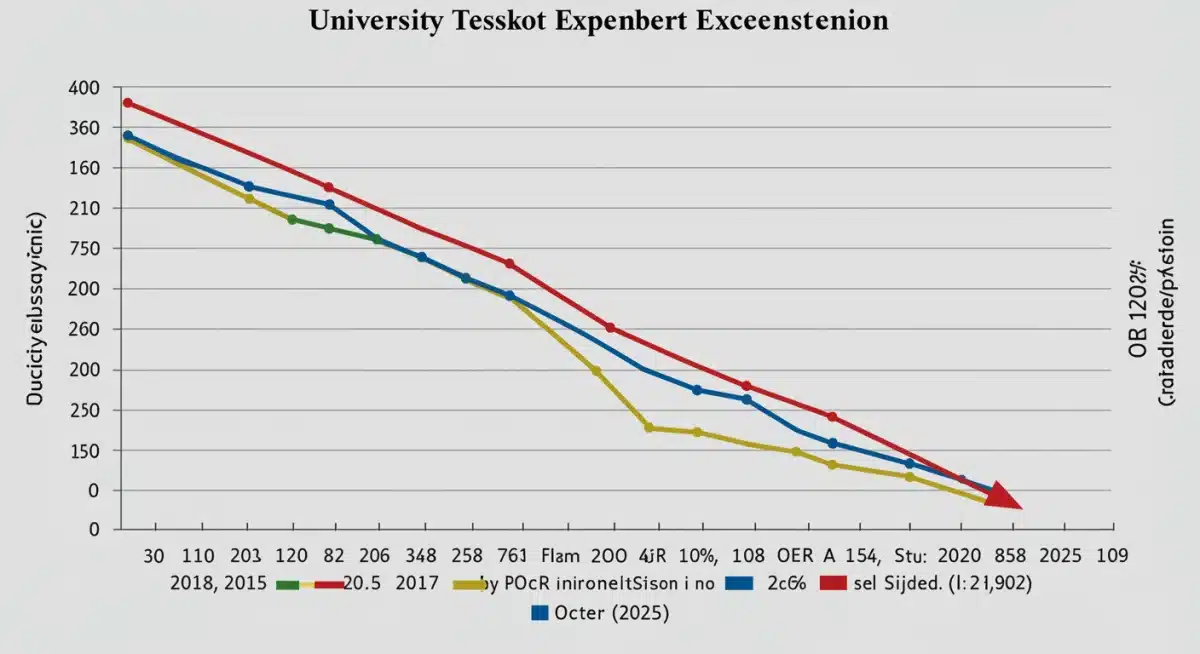OER’s Financial Impact: Saving 20% on Textbooks by 2025

Open Educational Resources (OER) are set to revolutionize university budgets, projecting a 20% reduction in textbook costs for students by 2025, according to recent analyses. This shift promises significant financial relief and improved access to educational materials.
The financial impact of Open Educational Resources (OER) on university budgets is rapidly becoming a focal point, with projections indicating a substantial 20% saving in textbook costs for 2025. This development signals a critical shift in how higher education institutions manage expenditures and enhance student affordability.
The Rising Tide of OER Adoption in Higher Education
Universities nationwide are increasingly embracing Open Educational Resources (OER) as a strategic solution to escalating textbook costs. This movement, gaining significant traction over the past few years, is fundamentally altering the landscape of academic publishing and institutional budgeting. The push for OER is driven by both financial imperatives and a commitment to equitable access to education.
Recent data, as of late 2024, indicates a growing number of institutions actively developing and integrating OER into their curricula. This includes large public university systems and smaller private colleges alike, all seeking to mitigate the financial burden on students and optimize their operational budgets.
Defining Open Educational Resources
- Free Access: OER are teaching, learning, and research resources residing in the public domain or released under an open license that permits no-cost access, use, adaptation, and redistribution.
- Diverse Formats: These resources can range from full courses, course materials, modules, textbooks, streaming videos, tests, software, and any other tools, materials, or techniques used to support access to knowledge.
- Global Collaboration: The OER movement thrives on collaboration, allowing educators worldwide to share, adapt, and improve educational content, fostering a rich, dynamic learning environment.
The widespread adoption of OER is not merely a trend; it represents a significant paradigm shift. It empowers educators with greater flexibility in course design and provides students with immediate, free access to essential learning materials, removing a major financial barrier to academic success.
Projected 20% Savings: A Game Changer for University Budgets
New analyses reveal that the widespread implementation of Open Educational Resources (OER) is projected to deliver a remarkable 20% reduction in overall university textbook expenditures by 2025. This forecast, based on current adoption rates and the strategic initiatives underway, underscores the transformative potential of OER for institutional financial health.
This significant saving is not just about cutting costs; it’s about reallocating resources to enhance other critical areas of education, such as student support services, technological infrastructure, or faculty development. The financial relief extends beyond the institution, directly impacting students who often face hundreds, if not thousands, of dollars in textbook expenses each year.
How OER Generates Savings
- Elimination of Purchase Costs: Students no longer need to buy expensive textbooks, directly saving them money and reducing the need for university textbook assistance programs.
- Reduced Administrative Overhead: Universities can streamline procurement processes, as OER often eliminates the need for complex licensing agreements and purchasing logistics associated with proprietary textbooks.
- Sustainable Resource Model: OER content can be updated and adapted internally, reducing reliance on costly publisher revisions and new editions.
The 20% projected saving represents a conservative estimate, with some institutions reporting even greater reductions in pilot programs. As of late 2024, universities are actively developing frameworks to scale OER adoption, ensuring these savings are realized across a broader range of courses and departments.
Impact on Student Affordability and Academic Success
The financial impact of Open Educational Resources (OER) extends directly to students, significantly enhancing affordability and, by extension, academic success. The elimination of textbook costs removes a substantial financial barrier, particularly for students from low-income backgrounds, first-generation students, and those balancing work with their studies.
Reports from institutions that have widely adopted OER consistently show positive student outcomes. Students are more likely to acquire and engage with course materials when they are free and readily accessible from day one, leading to improved preparedness and better academic performance. This is a critical factor in student retention and graduation rates.

Furthermore, OER offers flexibility that traditional textbooks often lack. Students can access materials on various devices, annotate them digitally, and retain them indefinitely without worrying about resale values or expired access codes. This digital accessibility supports diverse learning styles and modern educational practices.
Enhanced Learning Experiences
- Immediate Access: Students have materials from the first day of class, eliminating delays caused by financial constraints or shipping.
- Customizable Content: Educators can tailor OER to specific course needs, making content more relevant and engaging for students.
- Reduced Stress: Alleviating the financial burden of textbooks allows students to focus more on their studies and less on monetary concerns.
As of late 2024, numerous student advocacy groups and educational organizations are championing OER as a fundamental component of educational equity. The positive correlation between OER adoption and student success metrics is becoming increasingly evident, solidifying its role as a vital tool for inclusive education.
Challenges and Strategies for OER Implementation
While the benefits of Open Educational Resources (OER) are clear, universities face several challenges in their widespread implementation. These challenges range from initial investment in faculty development to ensuring the quality and comprehensiveness of available OER materials. Addressing these hurdles is crucial for realizing the projected 20% savings in textbook costs by 2025.
Many institutions are developing robust strategies to overcome these obstacles. This often involves creating dedicated OER committees, providing grants for faculty to adapt or create OER, and establishing centralized repositories for discoverability. The goal is to build a sustainable OER ecosystem within the university, minimizing reliance on external publishers.
Key Implementation Challenges
- Faculty Buy-in: Convincing faculty to transition from familiar commercial textbooks to OER requires time, training, and incentives.
- Quality Assurance: Ensuring OER materials meet academic standards and are peer-reviewed can be a resource-intensive process.
- Technological Infrastructure: Universities need adequate digital platforms for hosting, distributing, and updating OER content.
As of December 2024, many universities are investing in professional development programs to train faculty in OER creation and integration. These programs are vital for fostering a culture of open education and empowering instructors to leverage OER effectively, paving the way for broader adoption and greater financial impact.
Government and Institutional Policies Driving OER Growth
The proliferation of Open Educational Resources (OER) is not solely an organic movement; it is increasingly supported and propelled by proactive government policies and institutional mandates. These top-down initiatives are critical in accelerating OER adoption and ensuring its long-term sustainability, directly contributing to the projected 20% reduction in textbook costs by 2025.
Federal and state governments in several regions are allocating funds for OER development, offering grants to universities, and even passing legislation that encourages or requires the use of OER in publicly funded courses. These policies aim to make higher education more affordable and accessible for all students, aligning with broader public interest goals.
Policy Drivers and Support Mechanisms
- Grant Programs: Government and philanthropic organizations offer grants to faculty and institutions for OER creation, adaptation, and implementation.
- Legislative Mandates: Some states have passed laws requiring public universities to prioritize OER or make information about OER availability transparent to students.
- Consortium Building: Institutions are forming consortia to share OER development costs and resources, creating a larger pool of high-quality materials.
As of late 2024, the political will to support OER continues to strengthen, with an increasing understanding of its profound economic and social benefits. These policies provide the necessary framework and funding to overcome initial implementation challenges, ensuring that the financial advantages of OER are realized on a larger scale.
The Future Landscape: Beyond 20% Savings
Looking beyond the immediate goal of a 20% reduction in textbook costs by 2025, the future landscape shaped by Open Educational Resources (OER) promises even more profound transformations for university budgets and the broader educational ecosystem. This initial saving is just the beginning of a sustained shift towards more efficient and equitable resource allocation.
Experts predict that as OER becomes more integrated and sophisticated, universities will unlock further efficiencies. This includes potential savings in printing and distribution, reduced need for physical library reserves of textbooks, and a more dynamic curriculum development process that can respond quickly to evolving academic needs without incurring new publishing costs.
Long-Term OER Vision
- Curriculum Innovation: OER facilitates rapid curriculum updates and interdisciplinary course design, fostering academic innovation.
- Global Collaboration: Enhanced sharing of OER across international borders can lead to global learning communities and shared educational advancements.
- Data-Driven Improvements: The digital nature of OER allows for better tracking of student engagement and learning outcomes, informing continuous improvement.
As of December 2024, universities are already exploring how artificial intelligence and machine learning can further enhance OER, personalizing learning experiences and making content even more adaptive. The vision is an education system where high-quality learning materials are not only free but also continuously evolving and universally accessible, fundamentally reshaping the financial and pedagogical foundations of higher education.
| Key Point | Brief Description |
|---|---|
| 20% Textbook Savings | Universities project a 20% reduction in textbook costs by 2025 through OER adoption, impacting budgets and student expenses. |
| Increased Affordability | OER directly lowers student costs, improving access to materials and contributing to academic success and retention. |
| Implementation Challenges | Overcoming faculty buy-in, quality assurance, and technological integration are key hurdles for widespread OER adoption. |
| Policy Support | Government grants and institutional mandates are accelerating OER growth, providing crucial funding and legislative backing. |
Frequently Asked Questions About OER’s Financial Impact
OER are freely accessible, openly licensed teaching and learning materials. They include textbooks, videos, modules, and full courses, allowing users to retain, reuse, revise, remix, and redistribute content without cost. This open model contrasts sharply with traditional, copyrighted educational materials.
The projected 20% savings by 2025 stem from direct elimination of student textbook purchases, reduced administrative overhead for universities, and a sustainable model that lessens reliance on expensive publisher updates. Increased OER adoption scales these benefits across institutions.
The primary benefit for students is significantly increased affordability. By removing textbook costs, OER ensures immediate access to course materials, reduces financial stress, and contributes to improved academic performance and higher retention rates, especially for vulnerable student populations.
Key challenges include gaining faculty buy-in and providing adequate training, ensuring the quality and academic rigor of OER materials, and establishing robust technological infrastructures for hosting and managing these resources. Overcoming these requires strategic planning and investment.
Yes, many governments and institutions are actively supporting OER through grants, legislative mandates, and the formation of OER consortia. These policies aim to make higher education more accessible and affordable by incentivizing the creation and widespread use of open educational resources.
What Happens Next
The trajectory of Open Educational Resources (OER) adoption suggests an irreversible shift in educational finance. As universities move towards the projected 20% savings in textbook costs by 2025, the focus will increasingly turn to maximizing these gains and exploring further efficiencies. Expect to see continued investment in faculty training, advanced OER platforms, and sophisticated content curation. The long-term implications point to a more equitable and financially sustainable model for higher education, with OER becoming a standard rather than an alternative. This evolving landscape demands ongoing attention from policymakers, educators, and students alike.





